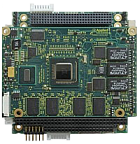 ISIS
Intel Atom Low Power PC/104 Plus CPU Module
The ISIS processor board provides the low power and rich feature set of Intel's Atom LPIA architecture in PC/104‑Plus form factor.
The ISIS module consists of a PC/104‑Plus carrier board coupled with the Catalyst module and requires under than 8W at up to 1.6GHz
The ISIS is ideal in any design where X86 compatibility, low power, high performance and a wide range of peripherals must be combined; it is also perfect to bring new life to existing projects by providing a simple and effective upgrade path for legacy PC104 CPU modules.
ISIS
Intel Atom Low Power PC/104 Plus CPU Module
The ISIS processor board provides the low power and rich feature set of Intel's Atom LPIA architecture in PC/104‑Plus form factor.
The ISIS module consists of a PC/104‑Plus carrier board coupled with the Catalyst module and requires under than 8W at up to 1.6GHz
The ISIS is ideal in any design where X86 compatibility, low power, high performance and a wide range of peripherals must be combined; it is also perfect to bring new life to existing projects by providing a simple and effective upgrade path for legacy PC104 CPU modules.
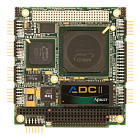 CME137686HR
PC/104-Plus Single Board Computer
The CME137686LX is an ultra low-power PC/104 single board computer with a PC/104-Plus stackable bus structure. This AMD Geode LX based CPU is an excellent solution for applications requiring real-time computing.
Key Features
PC/104 Form Factor
PC/104-Plus Stackable Bus Structure
Complete PC-compatible Single Board Computer (SBC)
Available in modular, rugged enclosures
AMD Geode LX800
333 MHz and 500 MHz processor options
High Reliability PCB built to IPC-6012 Class 3 standard
Nonvolatile storage of CMOS settings without battery
Stackable 104-pin PC/104 AT bus
Stackable 120-pin PCI bus
4 Bus master capable
BGA DDR SDRAM (Surface-Mounted)
256MB and 512MB options
32-pin SSD socket:
Removable Onboard Miniature Industrial ATA/IDE Flash Drive up to 8GB (1GB standard)
Flash Drive PIO Mode with BIOS-configured write protect function (available upon request)
Natively supported by all major operating systems
multiPort with Parallel Port, Floppy Drive Interface and 18-bit Digital I/O Port with Advanced Digital Interrupt Modes
Intel 82551QM Fast Ethernet
100Base-Tx and 10Base-T
Four RS-232/422/485 Ports
Two USB 2.0 (Universal Serial Bus) Ports
EIDE Controller with UltraDMA 33/66/100
AMD Geode LX Graphics Processor
Advanced power management features
ACPI 2.0 Compliant
Supported power down modes: S1 (Power On Suspend), S3 (Suspend to RAM), S4 (Hibernate), and S5 (Soft-Off)
Advanced Thermal Management
Hardware monitor for CPU temperature, board temperature, and power supply voltages
Passive Structural Heatsink & Heatpipes in IDAN and HiDAN System Configurations
15 interrupt channels
3 timer/counter channels
RTD Enhanced BIOS with USB Boot and Quick Boot modes
3.3V or 5V PCI bus signaling
Supports MMX and 3DNow!™ instructions
Math coprocessor
Internal Cache
L1 — 64KB of instruction and 64KB data; L2 — 128KB
Y2K compliant real time clock (external battery required)
Watchdog timer
PS/2 Mouse Port
Keyboard Port
Speaker Port
-40 to +85°C standard operating temperature
Heat Sink Options
Thermal-optimized passive heat sink included (standard)
Modified heat sinks and flat heat spreaders are available
For all RTD products, modifications are available upon request
CME137686HR
PC/104-Plus Single Board Computer
The CME137686LX is an ultra low-power PC/104 single board computer with a PC/104-Plus stackable bus structure. This AMD Geode LX based CPU is an excellent solution for applications requiring real-time computing.
Key Features
PC/104 Form Factor
PC/104-Plus Stackable Bus Structure
Complete PC-compatible Single Board Computer (SBC)
Available in modular, rugged enclosures
AMD Geode LX800
333 MHz and 500 MHz processor options
High Reliability PCB built to IPC-6012 Class 3 standard
Nonvolatile storage of CMOS settings without battery
Stackable 104-pin PC/104 AT bus
Stackable 120-pin PCI bus
4 Bus master capable
BGA DDR SDRAM (Surface-Mounted)
256MB and 512MB options
32-pin SSD socket:
Removable Onboard Miniature Industrial ATA/IDE Flash Drive up to 8GB (1GB standard)
Flash Drive PIO Mode with BIOS-configured write protect function (available upon request)
Natively supported by all major operating systems
multiPort with Parallel Port, Floppy Drive Interface and 18-bit Digital I/O Port with Advanced Digital Interrupt Modes
Intel 82551QM Fast Ethernet
100Base-Tx and 10Base-T
Four RS-232/422/485 Ports
Two USB 2.0 (Universal Serial Bus) Ports
EIDE Controller with UltraDMA 33/66/100
AMD Geode LX Graphics Processor
Advanced power management features
ACPI 2.0 Compliant
Supported power down modes: S1 (Power On Suspend), S3 (Suspend to RAM), S4 (Hibernate), and S5 (Soft-Off)
Advanced Thermal Management
Hardware monitor for CPU temperature, board temperature, and power supply voltages
Passive Structural Heatsink & Heatpipes in IDAN and HiDAN System Configurations
15 interrupt channels
3 timer/counter channels
RTD Enhanced BIOS with USB Boot and Quick Boot modes
3.3V or 5V PCI bus signaling
Supports MMX and 3DNow!™ instructions
Math coprocessor
Internal Cache
L1 — 64KB of instruction and 64KB data; L2 — 128KB
Y2K compliant real time clock (external battery required)
Watchdog timer
PS/2 Mouse Port
Keyboard Port
Speaker Port
-40 to +85°C standard operating temperature
Heat Sink Options
Thermal-optimized passive heat sink included (standard)
Modified heat sinks and flat heat spreaders are available
For all RTD products, modifications are available upon request
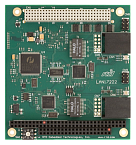 LAN17222HR
PC/104-Plus Dual RJ45 Gigabit Ethernet Module
The LAN17222 Gigabit Ethernet module features two independent GigE connections via Intel 82574IT Gigabit Ethernet controllers. Onboard multi-colored LEDs allow monitoring of link status, speed, and activity for each port. External LED connectors can be used in enclosures such as RTD’s rugged IDAN modular packaging system.
Key Features:
PC/104-Plus stackable bus structure
Two Independent Gigabit Ethernet Connections
1000/100/10 Mbps RJ45 on each channel
Full Duplex support
33 MHz, 32-bit PCI Interface
Multi-color LED to monitor link status, speed, and activity
Intel 82574IT Gigabit Ethernet Controller
Auto-Crossover for MDI/MDI-X at all speeds
Smart power-down at S0 no link and Sx no link
9 Kb Jumbo Frame Support with 40 Kb packet buffer size
IPv4, IPv6 support
MSI and MSI-X support
Support up to 256 K TCP
No heat sinking necessary
LAN17222HR
PC/104-Plus Dual RJ45 Gigabit Ethernet Module
The LAN17222 Gigabit Ethernet module features two independent GigE connections via Intel 82574IT Gigabit Ethernet controllers. Onboard multi-colored LEDs allow monitoring of link status, speed, and activity for each port. External LED connectors can be used in enclosures such as RTD’s rugged IDAN modular packaging system.
Key Features:
PC/104-Plus stackable bus structure
Two Independent Gigabit Ethernet Connections
1000/100/10 Mbps RJ45 on each channel
Full Duplex support
33 MHz, 32-bit PCI Interface
Multi-color LED to monitor link status, speed, and activity
Intel 82574IT Gigabit Ethernet Controller
Auto-Crossover for MDI/MDI-X at all speeds
Smart power-down at S0 no link and Sx no link
9 Kb Jumbo Frame Support with 40 Kb packet buffer size
IPv4, IPv6 support
MSI and MSI-X support
Support up to 256 K TCP
No heat sinking necessary
 CM313HR
Quad Serial Port with SMC9000 Ethernet Module
The CM313HR Communications utilityModule was designed to provide four versatile serial ports and an Ethernet interface to support the RTD cpuModules and other standard PC/104 processor modules.
CM313HR
Quad Serial Port with SMC9000 Ethernet Module
The CM313HR Communications utilityModule was designed to provide four versatile serial ports and an Ethernet interface to support the RTD cpuModules and other standard PC/104 processor modules.
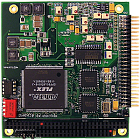 DM6430HR
True AT High Speed dataModule
The DM6430 analog I/O dataModule® turns your IBM AT‑compatible cpuModule or other PC/104 computer into a high-speed, high-performance data acquisition and control system.
DM6430HR
True AT High Speed dataModule
The DM6430 analog I/O dataModule® turns your IBM AT‑compatible cpuModule or other PC/104 computer into a high-speed, high-performance data acquisition and control system.
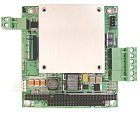 IPWR104HR
100 Watt Isolated Embedded Power Supply
The RTD IPWR104HR embedded power supply module provides an elegant solution for PC/104 systems requiring an isolated reliable power supply. The two available wide input voltage ranges of 18 - 36V and 33 - 75V will suit applications ranging from communications to aviation.
The IPWR104HR is available with a wide operating temperature range of -40 to +85 C. Power from the module is delivered to the PC/104 bus as well as to the card edge terminal blocks. Output voltages include +5 at 12A/20A, +12V at 2.0A and -12V at 500mA (100 Watt maximum combined output). These outputs are connected to the PC/104 bus as well as terminal blocks.
IPWR104HR
100 Watt Isolated Embedded Power Supply
The RTD IPWR104HR embedded power supply module provides an elegant solution for PC/104 systems requiring an isolated reliable power supply. The two available wide input voltage ranges of 18 - 36V and 33 - 75V will suit applications ranging from communications to aviation.
The IPWR104HR is available with a wide operating temperature range of -40 to +85 C. Power from the module is delivered to the PC/104 bus as well as to the card edge terminal blocks. Output voltages include +5 at 12A/20A, +12V at 2.0A and -12V at 500mA (100 Watt maximum combined output). These outputs are connected to the PC/104 bus as well as terminal blocks.
 CME136686LX333HR/500HR
PC/104 Ultra Low Power cpuModule & Controller with Advanced Digital I/O (aDIO)
RTD's CME136686LX cpuModule represents the latest in reliable low-power performance embedded computing solutions. It includes a 500 or 333MHz AMD Geode LX processor with 128kB L1 cache (64kB instruction and 64kB data) and 128kB L2 cache. It uses a 333MHz DDR-SDRAM controller that can support up to 2.7 G-Bytes per second of memory bandwidth.
The video interface is provided by an Analog SVGA output and an LVDS flat panel output. The two outputs are independent, and can display separate images and display timings. Maximum resolution is 1920 x 1440.
High-speed peripheral connections include USB 2.0, with up to 480 Mb/sec data throughput. An ATA-100/66/33 IDE controller provides a fast connection to the hard drive. Network connectivity is provided by an Intel 82551QM Ethernet controller. Network connectivity is provided by two Intel 82551QM Ethernet controllers. Other features include two RS-232/422/485 COM ports (four ports if in dual-port mode), and Parallel Port.
RTD has gone the extra mile to include additional advanced features for maximum flexibility. These include an ATA/IDE Disk Chip socket that allows a true IDE drive to be attached to the board, either socketed or soldered. A multiPort can be configured as a standard EPP/ECP parallel port, a floppy drive port, or an Advanced Digital I/O (aDIO) port. SDRAM is soldered directly to the board for high vibration resistance. The CME136686LX is also available in a rugged, fanless IDAN enclosure.
CME136686LX333HR/500HR
PC/104 Ultra Low Power cpuModule & Controller with Advanced Digital I/O (aDIO)
RTD's CME136686LX cpuModule represents the latest in reliable low-power performance embedded computing solutions. It includes a 500 or 333MHz AMD Geode LX processor with 128kB L1 cache (64kB instruction and 64kB data) and 128kB L2 cache. It uses a 333MHz DDR-SDRAM controller that can support up to 2.7 G-Bytes per second of memory bandwidth.
The video interface is provided by an Analog SVGA output and an LVDS flat panel output. The two outputs are independent, and can display separate images and display timings. Maximum resolution is 1920 x 1440.
High-speed peripheral connections include USB 2.0, with up to 480 Mb/sec data throughput. An ATA-100/66/33 IDE controller provides a fast connection to the hard drive. Network connectivity is provided by an Intel 82551QM Ethernet controller. Network connectivity is provided by two Intel 82551QM Ethernet controllers. Other features include two RS-232/422/485 COM ports (four ports if in dual-port mode), and Parallel Port.
RTD has gone the extra mile to include additional advanced features for maximum flexibility. These include an ATA/IDE Disk Chip socket that allows a true IDE drive to be attached to the board, either socketed or soldered. A multiPort can be configured as a standard EPP/ECP parallel port, a floppy drive port, or an Advanced Digital I/O (aDIO) port. SDRAM is soldered directly to the board for high vibration resistance. The CME136686LX is also available in a rugged, fanless IDAN enclosure.
 Model 812
8-Channel Frame Grabber
Sensoray Model 812 is an 8-channel PCI-Express frame grabber that can simultaneously capture 8 channels of NTSC/PAL video, plus optional 8 channels of mono audio. Each video channel captures at full frame rate 30 fps (for NTSC) or 25 fps (for PAL), which results in an aggregate frame rate of up to 240 fps (for NTSC) or 200 fps (for PAL). The board implements a single-lane (x1) PCI-Express interface that enables it to be plugged into any width of PCI-Express slots. All operating power is supplied from the PCI-Express bus and no external power supply is needed.
One model 812C1 cable (shown in image) is included with model 812, which can be used to connect eight video signals or eight audio signals to the board. In applications that require both audio and video inputs, an additional 812C1 cable should be purchased separately.
Video
All 8 composite video inputs are connected through a DB15 connector with a DB15-to-BNC breakout cable. An additional 34-pin connector can be used for breaking in the all composite video input signals as well. The video capture resolution can be chosen from D1, VGA, QVGA, CIF, 4CIF, SIF, 4SIF, etc. Captured frames could be in YUYV, UYVY, RGB555, or RGB565 formats.
Audio
All 8 mono audio inputs can be connected through a second DB15 connector with an optionally supplied DB15-to-BNC breakout cable. The 34-pin connector can be used for breaking-in the all audio input signals too. The audio sampling rate could be at 8K, 16K, 32K, 44.1K, or 48K Hz.
Digital I/Os
8 general-purpose digital I/O (DIO) signals are provided for camera control, status indication, or alarming, etc. They can be configured to function as inputs or outputs.
Software
A Software Development Kit (SDK) is currently available for Linux and an SDK for Windows is coming soon. The SDKs include drivers, programming samples, and comprehensive documentation to help users/programmers to quickly start and develop custom applications using the Model 812.
Applications
Sensoray Model 812 is designated for video surveillance applications. However, it can be used for all other multi-channel vision, image processing, and video capturing + recording applications. With chipset supplier's expectation, all video source signals are expected from stable video sources. The board is not suitable for week video signal sources and/or switching video source applications. To get better multi-channel perview performance on PCs with an Intel shipset, a discrete (non on-motherboard) graphic video card might be needed.
Model 812
8-Channel Frame Grabber
Sensoray Model 812 is an 8-channel PCI-Express frame grabber that can simultaneously capture 8 channels of NTSC/PAL video, plus optional 8 channels of mono audio. Each video channel captures at full frame rate 30 fps (for NTSC) or 25 fps (for PAL), which results in an aggregate frame rate of up to 240 fps (for NTSC) or 200 fps (for PAL). The board implements a single-lane (x1) PCI-Express interface that enables it to be plugged into any width of PCI-Express slots. All operating power is supplied from the PCI-Express bus and no external power supply is needed.
One model 812C1 cable (shown in image) is included with model 812, which can be used to connect eight video signals or eight audio signals to the board. In applications that require both audio and video inputs, an additional 812C1 cable should be purchased separately.
Video
All 8 composite video inputs are connected through a DB15 connector with a DB15-to-BNC breakout cable. An additional 34-pin connector can be used for breaking in the all composite video input signals as well. The video capture resolution can be chosen from D1, VGA, QVGA, CIF, 4CIF, SIF, 4SIF, etc. Captured frames could be in YUYV, UYVY, RGB555, or RGB565 formats.
Audio
All 8 mono audio inputs can be connected through a second DB15 connector with an optionally supplied DB15-to-BNC breakout cable. The 34-pin connector can be used for breaking-in the all audio input signals too. The audio sampling rate could be at 8K, 16K, 32K, 44.1K, or 48K Hz.
Digital I/Os
8 general-purpose digital I/O (DIO) signals are provided for camera control, status indication, or alarming, etc. They can be configured to function as inputs or outputs.
Software
A Software Development Kit (SDK) is currently available for Linux and an SDK for Windows is coming soon. The SDKs include drivers, programming samples, and comprehensive documentation to help users/programmers to quickly start and develop custom applications using the Model 812.
Applications
Sensoray Model 812 is designated for video surveillance applications. However, it can be used for all other multi-channel vision, image processing, and video capturing + recording applications. With chipset supplier's expectation, all video source signals are expected from stable video sources. The board is not suitable for week video signal sources and/or switching video source applications. To get better multi-channel perview performance on PCs with an Intel shipset, a discrete (non on-motherboard) graphic video card might be needed.
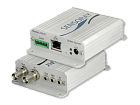 Model 2453/2454
IP Video Encoder/Decoder Server
Model 2453 is a compact IP video server that captures and compresses analog audio and NTSC/PAL video and sends the resulting streams over Ethernet. It can simultaneously produce two output streams with independent resolutions, frame rates, and bit rates, allowing it to be easily tailored to match network capabilities and application requirements. It provides a number of advanced features including deinterlacing with motion artifact removal, real-time text overlay, and image rotation and mirroring.
Video can be output as an elementary stream or multiplexed. A variety of stream formats are supported, including MPEG-4 (.m4v) and H.264 (.264 or .h264) elementary streams, MP4 (.mp4) and MPEG-2 transport stream (.ts) containers, and MJPEG (.mjpg or .mjpeg). The transport stream uses AAC audio and H.264 or MPEG-4 ASP video.
The overlay generators can position up to 160 characters of text anywhere in the video frame. A unique text string, consisting of mixed constant and variable text, may be defined for each overlay generator. Text variables such as time, date, and frame count are automatically updated every video frame.
A flexible serial port, configurable as RS232, RS422 or RS485 is provided for camera PTZ control or general-purpose use. Several other peripherals can be easily added with an optional 2453TAS board:
One digital input and one output, useful for alarms, lighting control or general purpose use. The output is optically isolated and the input may be optically isolated or galvanically coupled.
A host USB port for connection to external storage or wireless LAN.
An SD card socket that allows a removable flash card to serve as local storage for captured video and audio — useful for mitigating network congestion problems when data losses are unacceptable or for gapless monitoring during closed network access windows.
A battery that enables retention of date and time when the unit is not powered.
Model 2453 can also perform as a decoder, receiving a compressed audio/video stream over the network and converting it to standard analog video and audio signals (decoding is guaranteed only for streams captured with the 2453).
The built-in web server allows device configuration and control, user management, and live stream previewing on any web browser.
Customization of the 2453 user interface is easy. Controls that are not required can be hidden and page headers can be replaced with custom graphics. See the instructions for complete details.
Model 2453 is available in four configurations:
2453TAS — model 2453 + model 2453TA in metal enclosure;
2453S — model 2453 is in a low-profile metal enclosure;
2453 — a board version;
A miniature version of the product, model 2454, weighing less than one ounce, provides the same functionality as model 2453 using high density headers instead of standard connectors.
Model 2453/2454
IP Video Encoder/Decoder Server
Model 2453 is a compact IP video server that captures and compresses analog audio and NTSC/PAL video and sends the resulting streams over Ethernet. It can simultaneously produce two output streams with independent resolutions, frame rates, and bit rates, allowing it to be easily tailored to match network capabilities and application requirements. It provides a number of advanced features including deinterlacing with motion artifact removal, real-time text overlay, and image rotation and mirroring.
Video can be output as an elementary stream or multiplexed. A variety of stream formats are supported, including MPEG-4 (.m4v) and H.264 (.264 or .h264) elementary streams, MP4 (.mp4) and MPEG-2 transport stream (.ts) containers, and MJPEG (.mjpg or .mjpeg). The transport stream uses AAC audio and H.264 or MPEG-4 ASP video.
The overlay generators can position up to 160 characters of text anywhere in the video frame. A unique text string, consisting of mixed constant and variable text, may be defined for each overlay generator. Text variables such as time, date, and frame count are automatically updated every video frame.
A flexible serial port, configurable as RS232, RS422 or RS485 is provided for camera PTZ control or general-purpose use. Several other peripherals can be easily added with an optional 2453TAS board:
One digital input and one output, useful for alarms, lighting control or general purpose use. The output is optically isolated and the input may be optically isolated or galvanically coupled.
A host USB port for connection to external storage or wireless LAN.
An SD card socket that allows a removable flash card to serve as local storage for captured video and audio — useful for mitigating network congestion problems when data losses are unacceptable or for gapless monitoring during closed network access windows.
A battery that enables retention of date and time when the unit is not powered.
Model 2453 can also perform as a decoder, receiving a compressed audio/video stream over the network and converting it to standard analog video and audio signals (decoding is guaranteed only for streams captured with the 2453).
The built-in web server allows device configuration and control, user management, and live stream previewing on any web browser.
Customization of the 2453 user interface is easy. Controls that are not required can be hidden and page headers can be replaced with custom graphics. See the instructions for complete details.
Model 2453 is available in four configurations:
2453TAS — model 2453 + model 2453TA in metal enclosure;
2453S — model 2453 is in a low-profile metal enclosure;
2453 — a board version;
A miniature version of the product, model 2454, weighing less than one ounce, provides the same functionality as model 2453 using high density headers instead of standard connectors.
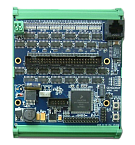 Model 2410
48-Channel Digital I/O Interface
Model 2410 is a compact open-frame module that interfaces 48 general-purpose TTL/CMOS compatible digital input/output (DIO) signals to a 10/100 Mbps Ethernet. It features advanced signal processing functions that reduce the host computer’s burden in measurement and control applications.
The module communicates through its built-in web and telnet servers, using telnet for automation applications and an embedded web site for configuration, manual control, and diagnostics. Precompiled API libraries are provided for Linux and Windows, along with open source (C language) code to enable porting and customization.
The unit has a small footprint, requires only a single 24VDC power source, and can be quickly and easily mounted by snapping it onto a standard DIN mounting rail. It will interface directly to many standard solid state relay racks, and it has an auxiliary power output that is capable of supplying 5VDC power to solid state relay racks or other modest external loads.
DIO Functions
Each open-collector DIO channel can operate as an input, an output, or in wired-or mode. A number of special functions such as debounce, edge detection, and PWM output, are available on each channel. All channels are synchronized to a common 1KHz clock to guarantee true state machine behavior. An LED indicates each channel’s physical state.
Software debounce can be enabled for any input signal, with debounce interval ranging from 0 to 255 milliseconds. Also, edge detection and capture may be enabled for any input signal and, if desired, asynchronous notification messages (i.e., «interrupts») will be sent to an Ethernet client when edge events are captured.
Outputs are capable of 24mA active-low output drive, and internal pull-up resistors are provided for all channels. Each output channel may be independently configured to function in the conventional fashion (directly controlled by Ethernet clients) or as a PWM generator with one millisecond resolution.
Signal Connections
A standard 50 pin header is provided for connecting the module to external solid-state relay racks or custom OEM signal distribution systems.
Sensoray also offers an optional termination board, Model 2410TA, which can be top-mounted to the module to add convenient field wiring terminal blocks without enlarging the module’s footprint. The spring-loaded terminals allow quick connection of 24-16 gauge wires.
LabVIEW Demo
In addition to the standard API, Sensoray provides a LabVIEW application which demonstrates how to interact the 2410.
Model 2410
48-Channel Digital I/O Interface
Model 2410 is a compact open-frame module that interfaces 48 general-purpose TTL/CMOS compatible digital input/output (DIO) signals to a 10/100 Mbps Ethernet. It features advanced signal processing functions that reduce the host computer’s burden in measurement and control applications.
The module communicates through its built-in web and telnet servers, using telnet for automation applications and an embedded web site for configuration, manual control, and diagnostics. Precompiled API libraries are provided for Linux and Windows, along with open source (C language) code to enable porting and customization.
The unit has a small footprint, requires only a single 24VDC power source, and can be quickly and easily mounted by snapping it onto a standard DIN mounting rail. It will interface directly to many standard solid state relay racks, and it has an auxiliary power output that is capable of supplying 5VDC power to solid state relay racks or other modest external loads.
DIO Functions
Each open-collector DIO channel can operate as an input, an output, or in wired-or mode. A number of special functions such as debounce, edge detection, and PWM output, are available on each channel. All channels are synchronized to a common 1KHz clock to guarantee true state machine behavior. An LED indicates each channel’s physical state.
Software debounce can be enabled for any input signal, with debounce interval ranging from 0 to 255 milliseconds. Also, edge detection and capture may be enabled for any input signal and, if desired, asynchronous notification messages (i.e., «interrupts») will be sent to an Ethernet client when edge events are captured.
Outputs are capable of 24mA active-low output drive, and internal pull-up resistors are provided for all channels. Each output channel may be independently configured to function in the conventional fashion (directly controlled by Ethernet clients) or as a PWM generator with one millisecond resolution.
Signal Connections
A standard 50 pin header is provided for connecting the module to external solid-state relay racks or custom OEM signal distribution systems.
Sensoray also offers an optional termination board, Model 2410TA, which can be top-mounted to the module to add convenient field wiring terminal blocks without enlarging the module’s footprint. The spring-loaded terminals allow quick connection of 24-16 gauge wires.
LabVIEW Demo
In addition to the standard API, Sensoray provides a LabVIEW application which demonstrates how to interact the 2410.
